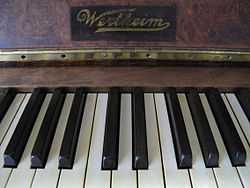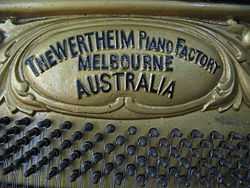Wertheim Piano
 The logo and keys of a late Wertheim upright piano from between 1925-1930 | |
| Industry | Musical instruments |
|---|---|
| Founded | 1880s (imports), 1908 (current) |
| Founder(s) | Hugo Wertheim (1854-1919) |
| Headquarters | Melbourne, Australia |
| Key people | Hugo Wertheim, Herbert Wertheim |
| Products | Grand pianos and upright pianos |
| Employees | 300-400 at peak |
Wertheim is an Australian brand of pianos, formerly produced in Richmond, a suburb of Melbourne, Australia. Around 18,000 upright pianos were made in Melbourne between 1908 and 1935, they were designed for the south-eastern Australian climate and were a popular all-purpose piano.
They were used in a range of settings such as schools and public halls, as they were renowned for their ability to stay in tune for prolonged periods of time, requiring little maintenance. They were also used by piano teachers and for professional live performance, the most famous of which was for performances by Dame Nellie Melba, who frequently requested that Wertheim Pianos be used during her performances.[1]
The business was very successful and the Wertheim family achieved celebrity status in Australia during the 1920s, however after the 1929 depression and with declining demand for pianos, the factory closed in 1935. Today, Wertheim is still an Australian owned company and the Wertheim brand name is used for a range of pianos that are produced overseas in China and South Korea.[2] Original Wertheim pianos undamaged and fully restored can be potentially quite valuable.
History

Early History
Hugo Wertheim migrated from Frankfurt, Germany to Melbourne, Australia as a reasonably wealthy man, in 1875 after being sent by his father, Meyer Wertheim, to travel the world as an agent for the family's sewing machine business. He opened two showrooms in Bourke & Collins Streets, importing German goods such as pianos, harmoniums and bicycles, but later focussed his attention on the demand for pianos in the then, new colony of Australia. Wertheim began importing cheap German pianos and re-badging them as "The Planet" and "Habsburg Wertheim" possibly as early as 1880.[1] Around the turn of the century, Wertheim sent his eldest son, Herbert, to learn the piano manufacturing trade in the United States and tour the continent before returning to run the new Melbourne enterprise.[3]
1908-1918
While Wertheim's son was overseas, he commissioned architect Nahum Barnet, who had worked for Steinway, Bechstein, Kaps and others, to design a prestigious factory. Wertheim spent somewhere between $25 and 75 thousand on the factory which was designed in a Free Arts & Crafts style applied to an industrial building. The investment was of such significance in Australia at the time that Prime Minister Alfred Deakin laid the factory's foundation stone on 21 October 1908. The structure was built by R. McDonald on 4 acres (16,000 m2) of land at 22 Bendigo Street, Richmond and when completed hosted 50,000 squares of space, its own power generator and tram line. At its peak, the factory was the largest piano factory in Australia, employed around 300 people and produced up to 2,000 pianos a year, including 12 grand pianos.[4]
1919-1935
Hugo Wertheim died in 1919, leaving his son Herbert, to run the business. His father's investment in the factory paid off both financially and socially, and the Wertheim family enjoyed celebrity status in Australia. This was particularly noteworthy as a generation of the Wertheim family were non practicing Jews, yet enjoyed "Melbourne Club status" during a time of anti-Semitism.[3] However, by the late 1920s, none of the third generation of the family was interested in running the business, which also suffered from the 1929 depression. The Wertheim's struggled on by sharing the Richmond site with three competitors Allan's, Paling's and Sutton's. In the early 1930s, the great depression and the popularity of the wireless decreased demand for pianos and the factory was closed in 1935 after producing around 18,000 pianos over 27 years.
Recent History
The closure of the Wertheim factory was somewhat of a family disagreement, as Herbert wanted to continue producing pianos while his mother did not, she had a casting vote on the board which decided to sell the property to Heinz to become the site for food preserving. With the advent of television in the 1950s, the then disused factory became the studios for the GTV 9 television station in 1956.[4]
1908-1935 Pianos

These pianos were hand crafted in the factory on Bendigo Street, Richmond, using predominantly Australian materials. These were the first pianos ever manufactured in the state of Victoria. Around 18,000 were produced, many were exported interstate and overseas.[4] They were used for many purposes, from live performance to performance halls, school theatres and by piano teachers. They were designed for the Australian climate and were noted for their ability to stay in tune for long periods of time. Many of these pianos are still in use today around Australia and, undamaged or restored, can be quite expensive.
Types
Upright Pianos:
- Concert Upright?
- Gold frame model?
- original prices?
- H9482 (serial number, 1920)
Grand Pianos:
- original prices?
- models?
Player Pianos:
- original prices?
- models?
Current Pianos
The Wertheim brand continues to be used on a range of pianos which are manufactured by Young Chang in Soul, South Korea and Tianjin, China under Australian quality control guidelines by "Piano Time". Wertheim Gold series pianos are made in the Tianjin factory, while Wertheim Platinum Series pianos are made in the South Korean factory. There are six models of Grand Piano and six models of Upright Piano, a range of modern and traditional styles are available in black and various wood grain finishes. The sound boards are made from solid Sitka Spruce, while Mahogany, Walnut and Ebony are used for the finishes. All models feature agraffe system.[2]
Types
Grand Pianos:
- range from $12000 to $100,0000AUD
- W150 EP (black )
- W150 MBP( Mahogany Brown Polish )
- W150 White
- W185 EP (Black )
- AW185 EP ( Black )
- AW208 EP ( Black )
- AW228 EP ( Black )
- AW275 EP ( Black )
Upright Pianos:
- range from $4000 to $12000AUD
- W114 EP ( Black )
- W121 EP ( Black )
- W121 MBP (Mahogany Brown Polish )
- W121 White
- W131 EP (Black)
- W131 MBP (Mahogany Brown Polish)
- AW121 EP ( Black )
- AW121 MBCP ( Satin Walnut )
- AW131 EP ( Black )
Other information
- Dame Nellie Melba was known to frequently request that Wertheim Pianos be used for her performances.[1]
- The street on the northern boundary of the Bendigo Street Factory was named after Wertheim.
- Former Victorian premier Jeff Kennett is a great grandson of Hugo Wertheim.[3]
- The Bendigo Street Factory is protected by local heritage laws and is under consideration for state heritage listing.[4]
See also
Australian Pianos:
- Beale Piano
- Overs Piano
- Stuart and Sons